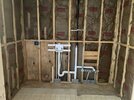As part of the house renovation we're doing, we plan to replace (most of) the old insulation, as well as insulate the interior walls for sound dampening. It turns out that there was a miscommunication with the insulation crew, and they apparently thought we were going to do the minimal job and only put (new) insulation where the old stuff was missing and in the new area that was a car port. One thing I noticed, which leads to my question, is that the new insulation does NOT have a vapor barrier on it. I have been trying to read up on whether or not a vapor barrier is required in our climate (Central NC - a bit south of and between Greensboro and Raleigh) but can't get a definite answer.
Does anyone have an expert opinion on this subject?
Does anyone have an expert opinion on this subject?


